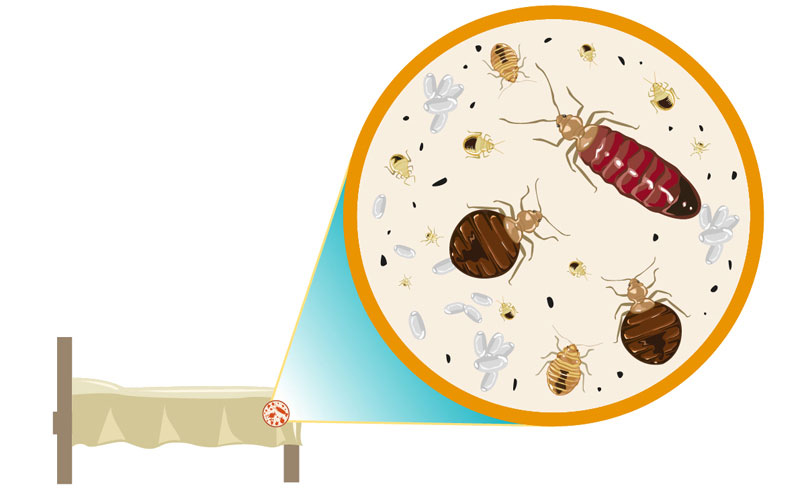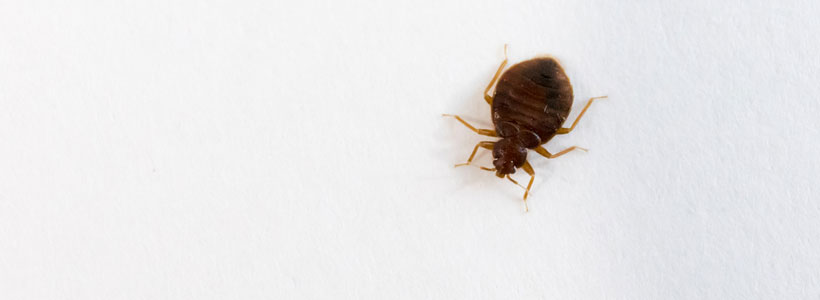Ten years ago a bed bug infestation in any area of the United States would have been a rare occurrence, even though these small blood-sucking insects have been associated with mankind probably since man lived in caves. Today, bed bugs are making a notable resurgence. A primary reason for this is the decrease in the use of broad spectrum pesticides that kept these pests in check. Secondarily, the increase and speed at which, humans can travel assists the spread of these insects. New infestations are often the results of these pests “hitch-hiking” on or in luggage, boxes, clothes or furniture.
Bed Bugs 101
Bed bugs are insects that are true bugs in the insect order Hemiptera and family Cimicidae. The most common bed bug associated with humans is Cimex lectularius L. (also known as the common bed bug) and this is the only species currently in Hawaii. The other species associated with humans is the tropical bed bug (Cimex hemipterus). They are small, wingless insects (about 3/8 inch in length), but are large enough to easily be seen by the eye. They are oval in shape and flattened in appearance. The life cycle is egg, five nymphal stages, and then adult. Under normal conditions growth takes 5-8 weeks from egg to adult. The nymphs look like the adults except for size. Bed bugs (male and female) feed only on the blood from mammals and birds. The female adult needs a blood meal to produce eggs and during a life span (up to 18 months) can produce 200-500 eggs. Bed bugs are nocturnal, but may feed during the day in area with reduced lighting such as theaters when no hosts are present at night.
Bed Bugs & Disease
Even though bed bugs feed on humans they are not known to vector any diseases to humans. So other than the itchy bite sites, they are of little medical importance.
Signs
The most obvious sign that you have encountered bed bugs is the presence of bites on the body. Most people have a very noticeable reaction to bed bug bites, including raised welts at the bite site and intense itching the next day. This is caused from the bed bug injecting saliva into the bite site to keep the host’s blood from coagulating while they feed. Along with the bites there often are blood spots on bed linens. These blood spots are from the bed bug taking in an overabundance of blood as it feeds and later as fecal spots as it digests the blood meal. Another sign, when there is a large population of bed bugs in a room, is a distinct pungent odor resembling spoiled raw beef and fruit mixed together. Of cause, the most obvious sign is finding the bed bugs themselves--including in the tucks of a mattress, on bed rails and frames or hiding in any crack or crevice.
Prevention
Prevention is the key to not having problems. If you travel and notice the signs of bed bugs while staying in hotels and motels, make sure you don’t bring them home with you. Inspect your luggage inside and out. Vacuum your luggage when you return and before you store it. Launder your clothing upon return.
If you purchase used furniture inspect and clean it thoroughly prior to introducing it to your home. The greatest risk is from used bed room furniture such as bed frames and mattresses.

Control
Since bed bugs are nocturnal, they will be hiding during the day in cracks, crevices, bed frames, under pictures hanging on walls, under dresser drawers and other places out of the light. The mentioned locations should be examined for the presence of bed bugs. These are the initial locations to apply controls. Since these insects don’t fly or jump, you can used a strong vacuum to remove them. After vacuuming you should use a stiff brush to dislodge any eggs. Cleaning with a strong detergent is recommended. Remove and launder all bed linens. Inspect the seams of the mattresses and box springs. High temperatures (over 114° F) will kill bed bugs. Small items infested with bed bug can be wrapped in dark plastic and placed in the sun for 4 to 8 hours. This should kill the bed bugs provided inside temperature of the package over 114°F. Commercially available insecticides labeled for bed bugs may also be used, but be sure to follow label directions.
If you decide to use a professional pest control company make sure that they are experienced in bed bug control and are licensed. A pest control operator should use an integrated pest management approach to the problem. This can involve the mechanical controls mentioned above as well as pesticides and other methods (such as heat treatments). Pesticides should include both residual chemicals and the insect growth regulators labeled for bed bug control.
CAUTION: Certain pesticides and their solvents may cause respiratory irritation. Persons with respiratory disease should consult their physicians before using any pesticide.
For further information and details, contact these Department of Health offices:
Island of Oahu 586-8021
Island of Hawaii 947-4238
Island of Maui 873-3560
Island of Kauai 241-3306




